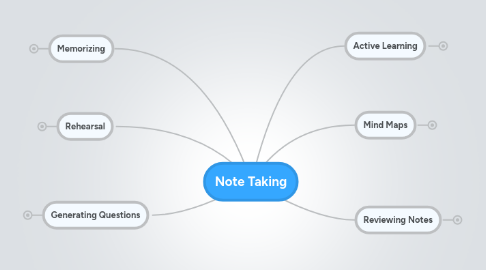
1. Mind Maps
1.1. "diagrammatic ways of organizing key ideas"
1.2. "emphasize the interconnection of concepts"
1.3. "illustrate the relative hierarchy of ideas"
2. Reviewing Notes
2.1. Use Cornell notes
2.1.1. Two columns
2.1.1.1. Left side questions and keywords
2.1.1.2. Right side notes
2.1.2. Space at the bottom
2.1.2.1. Summary
2.2. Constructing an Outline
2.2.1. structure all keywords and phrases into a formal outline
2.2.1.1. Headings
2.2.1.2. Sub-Headings
2.2.1.3. Detail Points
2.2.1.4. Examples
2.3. "study notes"
2.3.1. eliminate the "excess" notes you've taken
2.3.2. capture key ideas
2.3.3. bring a whole term's work together
2.4. Summary Paragraph
2.4.1. Ideally written from memory
2.4.2. Uses key words and phrases
2.4.3. defines, relates, and links terms to course material
3. Generating Questions
3.1. "gets you to think from your instructor's perspective"
3.2. Build questions based on key words and phrases
3.3. Use definition/summary questions
3.3.1. What is the meaning of <x>?
3.3.2. The basic idea of <x> is <y>.
3.4. Use analysis questions
3.4.1. What are the key aspects of <x>?
3.4.2. How does <x> relate or compare to <y>?
3.5. Use evaluation questions
3.5.1. What are the strengths and weaknesses of <x>?
3.5.2. Do I agree or disagree with <x> when they say <y>?
3.5.2.1. Why?
3.5.2.2. Why not?
4. Rehearsal
4.1. Combine information
4.1.1. Readings
4.1.2. Organized around key concepts
4.1.3. Notes
4.2. Make a list of Key:
4.2.1. Concepts
4.2.2. Topics
4.2.3. Words
4.2.4. Terms
4.2.5. Phrases
4.3. List possible test items
4.3.1. "this is a good test question"
4.3.2. Definitions
4.3.3. Lists
4.3.4. Discussion questions from key concepts
4.3.5. Compare and contrast questions for different points of view
4.4. Sample tests or test items
5. Memorizing
5.1. Group material around similarities
5.2. Use note cards as "flash cards"
5.3. Mnemonics and acronyms
6. Active Learning
6.1. Use different activities
6.1.1. reading
6.1.2. writing
6.1.3. reciting
6.1.4. flash cards
6.1.5. diagrams
6.1.6. quizzing

